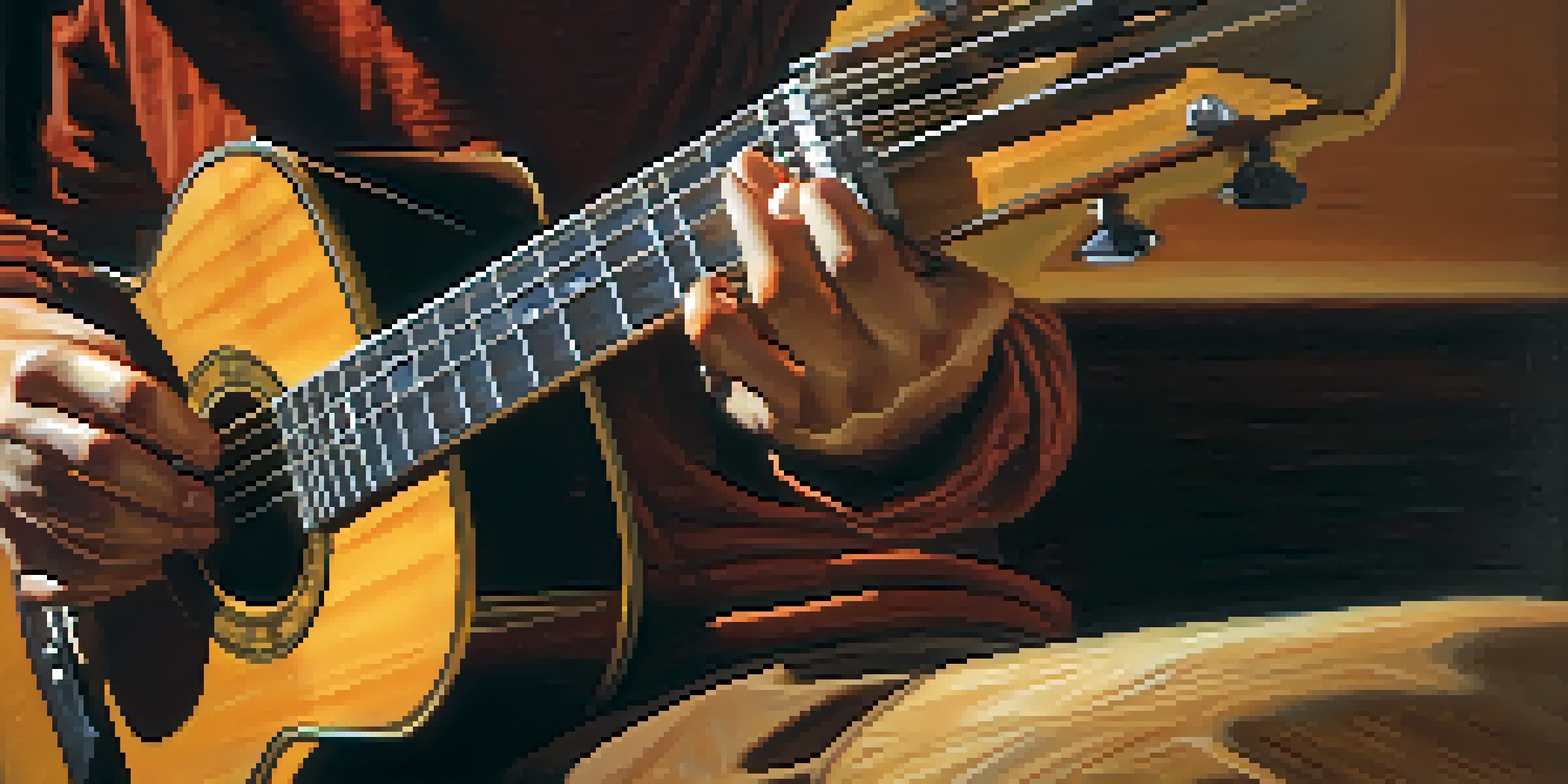Understanding the Basics of Guitar Fingerpicking Techniques

What is Fingerpicking in Guitar Playing?
Fingerpicking is a technique where you use your fingers to pluck the strings of the guitar instead of a pick. This style allows for a more nuanced sound, giving you the ability to play melodies and harmonies simultaneously. It's often associated with folk, classical, and blues music, creating a rich, textured sound that resonates with many listeners.
The guitar is a miniature orchestra in itself.
Imagine playing a lush garden of sound, where each finger represents a different flower, and together they create a beautiful bouquet. This method not only enhances the auditory experience but also offers a chance for personal expression. Many guitarists find that fingerpicking brings a unique intimacy to their music, allowing for deeper emotional connections.
Whether you’re strumming a simple chord or playing an intricate solo, understanding fingerpicking can elevate your guitar skills. It opens up a world of possibilities, making your playing more versatile and engaging. As you dive deeper into this technique, you'll discover its potential to transform your musical journey.
The Anatomy of Fingerpicking: Understanding Your Fingers
To master fingerpicking, it's essential to know which fingers to use for different strings. Typically, the thumb is assigned to the bass strings (E, A, D), while the index, middle, and ring fingers handle the higher strings (G, B, e). This division allows for a fluid, coordinated motion that can make your playing sound more polished.

Think of your fingers as a team, each with its own role to play in your musical ensemble. Just like a well-rehearsed band, they need to work together seamlessly to create harmony. Practicing with this structure in mind will help you develop muscle memory, making fingerpicking feel more natural over time.
Mastering Fingerpicking Basics
Understanding finger roles and practicing basic patterns are essential for developing fluidity and coordination in fingerpicking.
Understanding finger roles will not only improve your technique but also enhance your overall playing style. As you become more comfortable with each finger's function, you’ll start to notice how they can interact to create complex sounds and rhythms. This foundational knowledge is key to progressing in your fingerpicking journey.
Basic Fingerpicking Patterns to Get Started
When starting with fingerpicking, it's helpful to practice basic patterns to build your skills. One common pattern is the 'PIMA' technique, where P stands for the thumb, I for the index finger, M for the middle finger, and A for the ring finger. This simple sequence can serve as the foundation for more complex patterns as you progress.
Music is the shorthand of emotion.
Picture this pattern like a dance, where each finger has its own step to follow. By repeating these movements, you’ll develop rhythm and coordination, which are essential for fingerpicking. These patterns can be applied to various songs, making them versatile tools in your musical toolkit.
As you practice these basic patterns, you'll notice how they begin to flow more easily. This newfound fluidity will not only boost your confidence but also encourage you to experiment with different styles and genres. Remember, the more you practice, the more your fingers will learn to 'speak' the language of music.
Advanced Fingerpicking Techniques to Enhance Your Skills
Once you’re comfortable with the basics, it's time to explore advanced fingerpicking techniques. Techniques like harmonics, arpeggios, and thumb independence can add depth and complexity to your playing. Incorporating these advanced methods can help you stand out as a guitarist and allow you to express your creativity.
Think of these techniques as tools in a toolbox; each one serves a unique purpose in crafting your sound. For example, harmonics can create a bell-like tone, while arpeggios provide a flowing, melodic quality. Experimenting with these techniques can lead to exciting discoveries in your playing style.
Advanced Techniques to Explore
Incorporating advanced techniques like harmonics and arpeggios can enhance your fingerpicking skills and allow for greater musical expression.
As you delve into these advanced techniques, remember that patience is key. Mastery takes time and practice, but the rewards are well worth it. Your dedication will not only improve your fingerpicking skills but also deepen your appreciation for the guitar as an instrument.
The Role of Timing and Rhythm in Fingerpicking
Timing and rhythm are crucial elements in fingerpicking that can make or break your performance. Proper timing ensures that your notes sound crisp and clear, while a strong sense of rhythm adds the necessary groove to your playing. Practicing with a metronome can help you develop a steady pulse, which is essential for any guitarist.
Imagine timing as the heartbeat of your music, setting the pace for each note you play. Just as every living creature has a rhythm, your guitar playing needs one too. By mastering timing, you can create a more engaging and dynamic musical experience for your audience.
As you enhance your timing and rhythm skills, you'll find that your fingerpicking becomes more expressive. This newfound ability will allow you to play with greater confidence, whether you're performing for friends or on a larger stage. Remember, the right timing can turn a good performance into a memorable one.
Common Mistakes in Fingerpicking and How to Avoid Them
As with any skill, there are common mistakes that many guitarists make when learning fingerpicking. One prevalent issue is using too much tension in the fingers, which can lead to fatigue and hinder fluidity. To counteract this, focus on relaxing your hands and allowing your fingers to move freely over the strings.
Another common mistake is neglecting to keep a steady rhythm. Many beginners tend to rush through the notes or drag them out, which can disrupt the flow of the music. By practicing with a metronome and paying attention to your timing, you can avoid this pitfall and enhance your overall sound.
Avoiding Common Fingerpicking Mistakes
Being aware of common mistakes, such as tension in the fingers and improper timing, is key to achieving clarity and fluidity in your playing.
Finally, be mindful of finger placement on the strings. Incorrect positioning can lead to muted or buzzing notes, detracting from the clarity of your playing. Regularly checking your hand position and making adjustments as needed will help you maintain a clean and polished sound.
Resources and Tools to Improve Your Fingerpicking Skills
To elevate your fingerpicking skills, there are plenty of resources available that can aid your learning process. Online tutorials, instructional videos, and fingerpicking books can provide valuable insights and techniques. Many of these resources offer exercises specifically designed to enhance your fingerpicking abilities.
Consider joining online forums or local guitar groups where you can share tips and experiences with fellow guitarists. Learning from others can be incredibly beneficial, as it exposes you to different styles and approaches. Additionally, having a supportive community can keep you motivated and inspired along your journey.

Lastly, don't underestimate the power of practice. Setting aside dedicated time for fingerpicking practice each day will yield significant improvements over time. Embrace the learning process, and remember that every guitarist was once a beginner who persevered to master their craft.